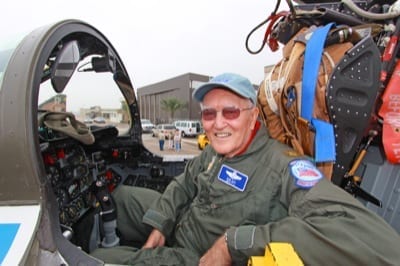By HUNTER CHANEY, Collings Foundation
With the sun glinting off the polished canopy, Bud Day grasped the yellow boarding ladder of his F-100F “Hun” and proceeded to make the long climb to the cockpit. Strapping into the ejection seat, he scanned the tarmac below. He had done this countless instances before — counting down the minutes before the start of anther sortie. This time, however, he was not looking at the surroundings of Phu Cat Air Base in South Vietnam. Instead, he viewed his family and friends, all eager to see him take to the sky for one last mission. Over four decades had passed since his last combat flight in the venerable “Hun,” but as the jet engine roared to life and the aircraft taxied to the runway, “his” airplane felt like home.
 When it comes to dedication to duty and bravery, Bud Day has few equals. He served in the Marine Corps during World War II and later earned his wings as an Air Force fighter pilot. In 1967, he volunteered for service in Vietnam and was shot down while flying an F-100F. As a prisoner of war for over five years, he was routinely subjected to brutal torture and was barely fed enough to stay alive. He was released on March 14, 1973, and returned to duty in the Air Force. Three years later, on March 6, 1976, President Gerald Ford presented Day with the Medal of Honor.
When it comes to dedication to duty and bravery, Bud Day has few equals. He served in the Marine Corps during World War II and later earned his wings as an Air Force fighter pilot. In 1967, he volunteered for service in Vietnam and was shot down while flying an F-100F. As a prisoner of war for over five years, he was routinely subjected to brutal torture and was barely fed enough to stay alive. He was released on March 14, 1973, and returned to duty in the Air Force. Three years later, on March 6, 1976, President Gerald Ford presented Day with the Medal of Honor.
Honoring veterans like Bud Day and educating subsequent generations about key chapters in America’s history is of immense importance. However, this is not a simple task when it comes to the air domain. As President George W. Bush once explained: “A soldier can walk the battlefields he once fought; a Marine can walk the beaches he once stormed; but an Airman can never visit the patch of sky he raced across on a mission to defend freedom.”
That is why we must ensure that historic military aircraft can still take to the sky in a “living” and accessible format. As Bud Day explained: “Going up in the F-100 really provided a unique opportunity to reflect upon missions I’ve flown and all the guys I served with. It means a lot.”
Nor does the value of experiencing historical flight end with the men and women who actually flew these aircraft first-hand — whether it is a grandchild seeking to understand what his or her grandparent did so many years ago, or a student learning about a chapter in our country’s history — historical flight experiences help the public better understand our nation’s past. There are some things that a history book, static museum display, or academic lecture cannot encapsulate — a person actually has to go out and experience it first-hand.
The ability for veterans and members of the general public to fly in historic military aircraft dates back to the mid-1990s, when the FAA authorized qualified organizations to offer flight experiences in specific historic aircraft. Recognizing the age of these planes and their unique operating parameters, the FAA required adherence to enhanced flight crew and aircraft maintenance standards — parameters greatly exceeding those for aircraft operating outside the program.
From the very beginning, the public has displayed overwhelming interest in these flights. Historic aircraft once confined to specific geographic regions are now able to travel across the nation on tours to honor veterans and educate younger generations about their nation’s history.
In many cases, these visits help veterans discuss their military service with family and friends — stories and experiences that may have laid dormant for decades.
Additionally, a continued emphasis on safety has yielded improved maintenance practices and highly professional flight operations. No passengers have been killed or injured as the result of an accident aboard a historical flight experience aircraft.
Despite this overwhelmingly positive track record, the FAA is now looking to curtail living historical flight experience programs. Cutting back on something that honors veterans, educates the public, and enhances safe flight operations makes no sense.
Organizations engaged in this endeavor should be commended for their efforts, not punished. Most importantly, we owe it to our veterans and their families to ensure this mission of recognition and education is allowed to continue. They gave so much for our country, we need to ensure we are allowed by the FAA to give back and honor their service.
The FAA is holding a public meeting to discuss the future of living historical flight experiences at its headquarters in Washington, D.C., June 26-28. We need your support at this session. FAA leaders need to know that the American public values its veterans and historical education. Living historical flight experiences matter — please engage on this issue before it is too late.
If you plan on attending the public hearings, please RSVP to the FAA at [email protected].
If you’d like to submit written comments, please post your remarks at Regulations.gov (reference docket number FAA-2012-0374). Deadline for comments is June 18.
Contact your Senators and Representatives: ContactingTheCongress.org
For more information: CollingsFoundation.org
People who read this article also read articles on airparks, airshow, airshows, avgas, aviation fuel, aviation news, aircraft owner, avionics, buy a plane, FAA, fly-in, flying, general aviation, learn to fly, pilots, Light-Sport Aircraft, LSA, and Sport Pilot.
